Reciprocating Hydrogen Compressor Market Research - 2032
The Global Reciprocating Hydrogen Compressor Market Size was valued at $914.3 million in 2022, and is projected to reach $1.6 billion by 2032, growing at a CAGR of 5.3% from 2023 to 2032.
Reciprocating hydrogen compressors are used for compressing hydrogen into smaller volumes for storing, transporting, and processing. Moreover, a reciprocating compressor consists of a piston or diaphragm, that withdraws the hydrogen gas during its retreating stroke, and compresses the hydrogen during its compression stroke. The reciprocating hydrogen compressors are used in oil & gas industries, chemical industries, hydrogen production plants, and others.
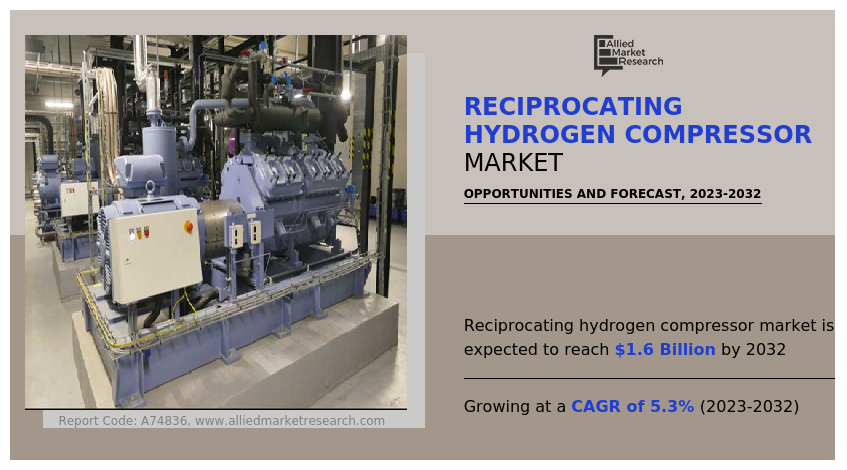
Market Dynamics
Hydrogen gas is a highly flammable, light, and odorless gas that is widely used in various industrial applications such as for refining petroleum, treating metals, producing fertilizer, processing food, clean transportation fuel as well as for clean energy production. Thus, growth in the abovementioned industries is expected to drive the demand for hydrogen; thereby, increasing the demand for reciprocating hydrogen compressors. For instance, in February 2022, British oil and gas company BP PLC signed an agreement with Hydrogen Chemistry Company (HyCC) to develop H2-Fifty, a 250MW green hydrogen plant, in the port area of Rotterdam, the Netherlands.
Furthermore, as environmental concerns grow, major countries across the world including, the U.S., European countries, Australia, China, Japan, and others, have introduced policies to support the domestic production of hydrogen, especially for clean energy. For instance, in March 2021, the Minister of Natural Resources announced $46,000 for funding of the Canadian Hydrogen and Fuel Cell Association (CHFCA), which will help in promoting the benefits of hydrogen fuel cell electric vehicles. Moreover, in October 2022, BASF, a chemicals conglomerate, received about $132.7 million by the German government for establishment of a large green hydrogen production plant.
The significance of reciprocating hydrogen compressors in the production, storage, and transportation of hydrogen is crucial. Thus, the growing need for hydrogen as a fuel source is propelling the reciprocating hydrogen compressor industry forward. Similarly, China aims to have 50,000 hydrogen fuel-cell vehicles on the road by 2025 and also build hydrogen refueling stations for these vehicles. The growth of hydrogen infrastructure, such as refueling stations and hydrogen pipelines, is increasing the demand for hydrogen compression solutions.
However, various disadvantages of hydrogen such as low energy density, and high flammability, which requires careful handling and storage to prevent accidents, are anticipated to restrain the reciprocating hydrogen compressor market growth.
Moreover, the increasing popularity of clean hydrogen such as blue hydrogen and green hydrogen, is anticipated to provide growth opportunities for the reciprocating hydrogen compressor market, and positively affecting the reciprocating hydrogen compressor market outlook.
The demand for reciprocating hydrogen compressors decreased in 2020, owing to reduced activities in oil refining, the chemical sector and steel manufacturing which are the major users of hydrogen gas in their processes. The COVID-19 pandemic led to the shutdown of the abovementioned sector, leading to a halt in demand for reciprocating hydrogen compressors. The major demand for reciprocating hydrogen compressors was previously noticed from major countries, including China, the U.S., Germany, Gulf countries, and countries in Latin. These countries were negatively affected by the spread of coronavirus, thereby halting the demand for reciprocating hydrogen compressors.
However, owing to the introduction of various vaccines, the severity of the COVID-19 pandemic reduced significantly. This has led to the full-fledged reopening of businesses involved in the reciprocating hydrogen compressor market and led to increased activities in the industrial sector. Furthermore, it has been around three years since the outbreak of this pandemic, and many companies have already shown notable signs of recovery. Contrarily, during the beginning of 2023, the number of COVID-19 cases surged again, especially in China, which brought negative sentiments to the market. In addition to COVID-19, another event, i.e., worldwide inflation, driven by the Ukraine-Russia war has also negatively affected the industrial sector.
Segmental Overview
The reciprocating hydrogen compressor market is segmented on the basis of compressor type, lubrication type, pressure, and product speed, application, end user industry, and region. By compressor type, the market is categorized into single acting, double acting, and diaphragm. Depending upon lubrication type, the market is bifurcated into oil-based and oil-free. Depending on pressure, the market is classified into less than 400 bar, 401-700 bar and more than 700 bar. Depending upon product speed, the market is categorized into low, medium, and high.
Depending upon application, the market is categorized into refueling stations, production, and storage, and industrial. On the basis of end user industry, it is divided into oil and gas, chemical, automotive, and others. Region wise, it is analyzed across North America (U.S., Canada, and Mexico), Europe (Germany, France, Italy, the UK, and rest of Europe), Asia-Pacific (China, India, Japan, South Korea, and rest of Asia-Pacific), and LAMEA (Latin America, Middle East, and Africa).
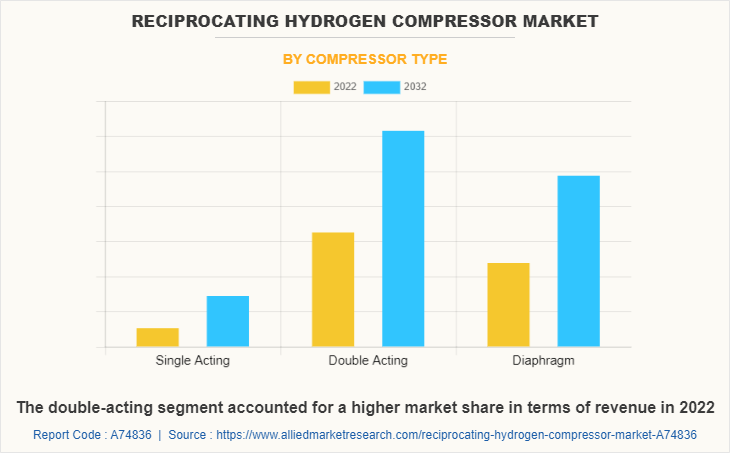
By Compressor Type:
The reciprocating hydrogen compressor market is divided into single acting, double acting, and diaphragm. In 2022, the double acting segment dominated the reciprocating hydrogen compressor market, in terms of revenue, and the diaphragm segment is expected to witness growth at a higher CAGR during the forecast period. High sales in the double acting segment are attributed to its high efficiency. Moreover, the diaphragm segment is growing at a higher CAGR, due to its cleaner and relatively silent operation.
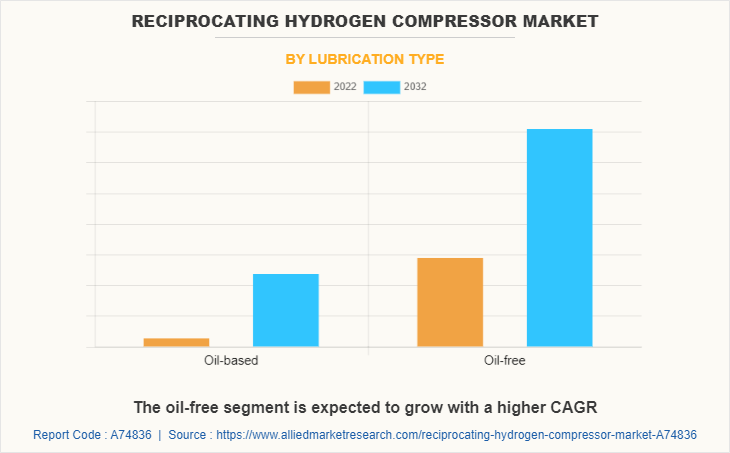
By Lubrication Type:
The reciprocating hydrogen compressor market is divided into oil-based, and oil-free. In 2022, the oil-free segment dominated the reciprocating hydrogen compressor market, in terms of revenue, and the oil-based segment is expected to grow at a higher CAGR during the forecast period. Compressors that are lubricated with oil are frequently used in a variety of heavy industrial uses, including petroleum, chemical, and others. Moreover, the provision of oil-free output gas by the oil-free air compressors is making them superior to oil-lubricated compressors.
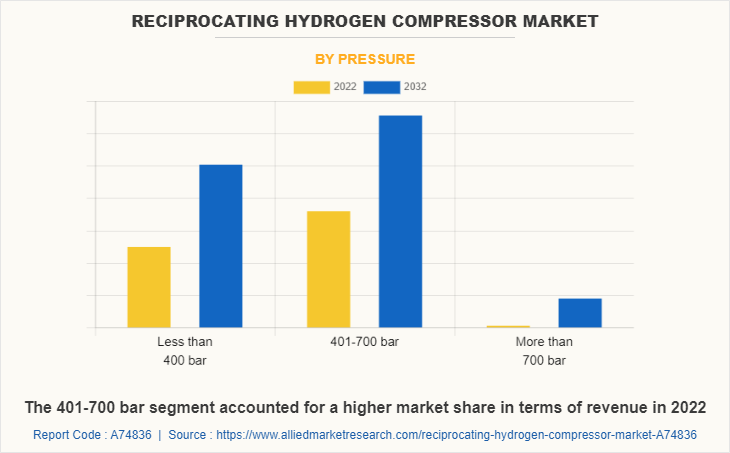
By Pressure:
The reciprocating hydrogen compressor market is divided into less than 400 bar, 401-700 bar, and more than 700 bar. The 401-700 bar segment accounted for a higher reciprocating hydrogen compressor market Share in 2022. However, the more than 700 bar segment is anticipated to register a higher growth rate throughout the forecast period. The demand for smaller, yet powerful compressors for use in mobile refueling stations and other applications is also driving the growth of the market for 401-700 bar compressors.
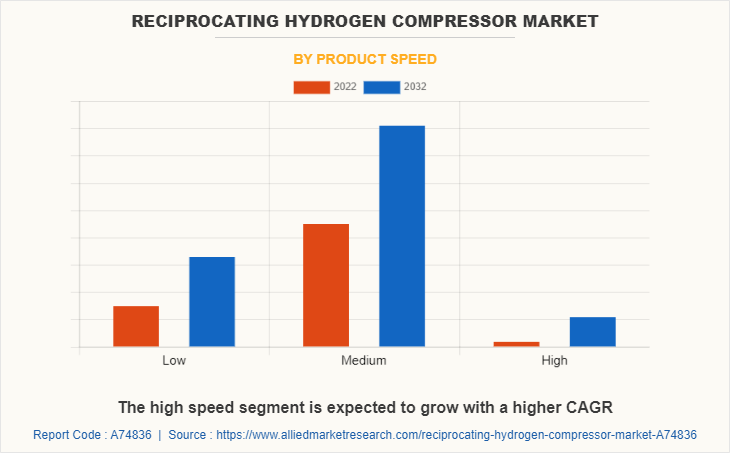
By Product Speed:
The reciprocating hydrogen compressor market is divided into low, medium, and high. In 2022, the medium segment dominated the reciprocating hydrogen compressor market, in terms of revenue, and the high segment is expected to witness growth at a higher CAGR during the forecast period. In addition, due to the increasing demand for hydrogen as a fuel source in various applications, including transportation, industrial, and energy storage, the medium segment witnessed higher sales revenue. However, the increasing demand for hydrogen as a clean and sustainable energy source is driving the demand for the high segment.
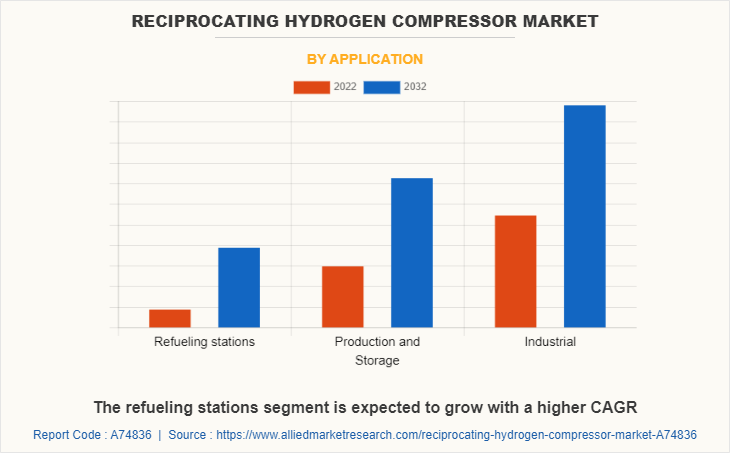
By Application:
The reciprocating hydrogen compressor market is divided into refueling stations, production, and storage, and industrial. In 2022, the industrial segment dominated the reciprocating hydrogen compressor market, in terms of revenue, is attributed to various government initiatives to decarbonize the industrial sector and growth in demand for clean energy. On the other hand, the refueling stations segment is expected to grow at a higher CAGR during the forecast period and is attributed to the increasing adoption of hydrogen fuel cell vehicles.
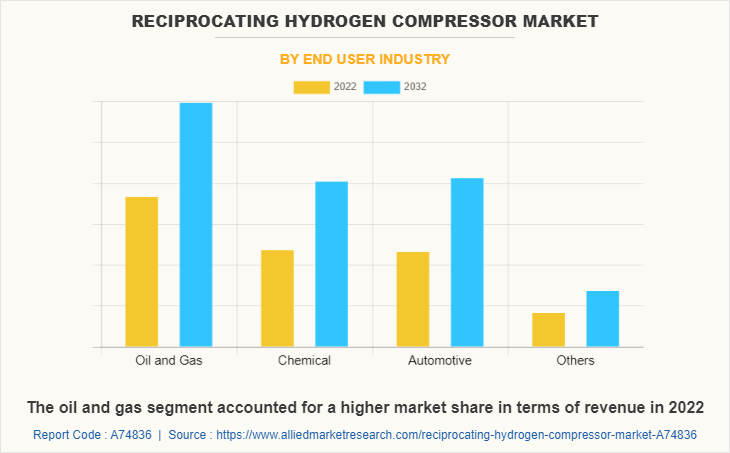
By End User Industry:
The reciprocating hydrogen compressor market is divided into oil and gas, chemical, automotive, and others. The oil and gas segment accounted for a higher market share in 2022. However, the automotive segment is anticipated to register a higher growth rate throughout the forecast period. The oil & gas industry is one of the major end users of air compressors globally. Reciprocating hydrogen compressors provide significant assistance in the oil and gas industry, by compressing the hydrogen gas to a required volume. Moreover, growing demand for energy-efficient and environmentally friendly vehicles is driving the market growth for the automotive segment.
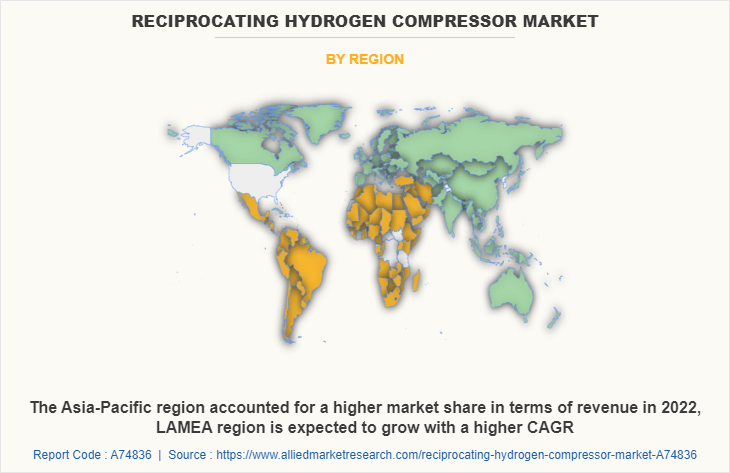
By Region:
Asia-Pacific accounted for the highest market share in 2022 and is expected to maintain its dominance throughout the projected period. This expansion is attributed to rapid economic growth, and industrialization, in countries such as China, India, Vietnam, and Indonesia. Moreover, the growing demand for hydrogen as an alternate source of energy is also expected to occur at a substantial rate in the region. Furthermore, LAMEA is expected to grow at the highest CAGR throughout the projected period.
The growing pollution is encouraging the governments in the region to adopt clean energy sources including the use of hydrogen in power plants and in fuel cell vehicles. Moreover, there are many oil and gas processing facilities in the region with the Middle East being in the forefront followed by Latin America. According to the Emirates Policy Center (EPC), a think tank in based in Emirates Policy Center, demand for low-carbon hydrogen is anticipated to witness growth significantly in the coming years, due to its significant role in achieving the Gulf Cooperation Council’s (GCC) net-zero targets.
Competition Analysis
Competitive analysis and profiles of the major players in the reciprocating hydrogen compressor market are provided in the report. Major companies in the report include, Atlas Copco AB, IDEX Corporation, Ingersoll Rand Inc., HAUG Sauer Kompressoren AG, Ariel Corporation, Hitachi, Ltd., Chart Industries, Inc. (Howden Group), Nel ASA, PDC Machines, Inc., Burckhardt Compression Holding AG, SIAD Macchine Impianti S.p.A., Minnuo Group, Siemens Energy AG, Mikuni Group, Indian Compressors Ltd., Kwangshin Machinery Co., Ltd., IHI Corporation, CET Engineering srl, Kobe Steel, Ltd., and NEUMAN & ESSER GROUP.
Key Benefits for Stakeholders
- The report provides an extensive analysis of the current and emerging reciprocating hydrogen compressor market trends and dynamics.
- In-depth reciprocating hydrogen compressor market analysis is conducted by constructing market estimations for key market segments between 2022 and 2032.
- Extensive analysis of the reciprocating hydrogen compressor market is conducted by following key product positioning and monitoring of top competitors within the market framework.
- A comprehensive analysis of all the regions is provided to determine the prevailing opportunities.
- The reciprocating hydrogen compressor market forecast analysis from 2023 to 2032 is included in the report.
- The key players within the reciprocating hydrogen compressor market are profiled in this report and their strategies are analyzed thoroughly, which helps understand the competitive outlook of the reciprocating hydrogen compressor industry
alt tag
Reciprocating Hydrogen Compressor Market Report Highlights
| Aspects | Details |
| Market Size By 2032 | USD 1.6 billion |
| Growth Rate | CAGR of 5.3% |
| Forecast period | 2022 - 2032 |
| Report Pages | 550 |
| By Compressor Type |
|
| By Lubrication Type |
|
| By End User Industry |
|
| By Application |
|
| By Pressure |
|
| By Product Speed |
|
| By Region |
|
| Key Market Players | SIAD Macchine Impianti S.p.A., Mikuni Group, Indian Compressors Ltd., Ingersoll Rand Inc., Burckhardt Compression Holding AG, IHI Corporation, Hitachi, Ltd., Kobe Steel, Ltd., PDC Machines, Inc., Nel ASA, HAUG Sauer Kompressoren AG, Minnuo Group, IDEX Corporation, Atlas Copco AB, Ariel Corporation, NEUMAN & ESSER GROUP, Chart Industries, Inc. (Howden Group), Siemens Energy AG, CET Engineering srl, Kwangshin Machinery Co., Ltd. |
Analyst Review
The reciprocating hydrogen compressor market has witnessed significant growth in the past few years owing to increased production of an energy-efficient energy source, that is hydrogen. In addition, industrial applications of hydrogen in oil & gas, and chemicals-producing industries are also a major driving factor for the reciprocating hydrogen compressor market.
For various operations such as refining, chemical synthesis, and power generation, the oil & gas sector uses a range of gases, including hydrogen. In addition, owing to its clean and efficient combustion features, hydrogen has grown in popularity as a feedstock and fuel source in the oil and gas sector. Reciprocating hydrogen compressors are used in the oil and gas sector for the production, storage, and transportation of hydrogen. Moreover, the growing demand for fuel cell vehicles that use hydrogen is driving the growth of hydrogen refueling stations, which are anticipated to have a major positive impact on the reciprocating hydrogen compressor market growth.
The constricted supply of fossil fuel to the world caused due to Ukraine-Russia war is estimated to act as a catalyst for market growth. This is because most of the countries are reducing their dependence on fossil fuels, especially the ones imported from Russia.
Key factors driving the growth of the reciprocating hydrogen compressor market include increase in use of hydrogen, necessity of compressing hydrogen, and growth of oil and gas industry.
The industrial segment under the applications dominated the reciprocating hydrogen compressor market, in terms of revenue in 2022.
Asia-Pacific accounted for the largest revenue share generated in 2022 in the world.
The global reciprocating hydrogen compressor market was valued at $914.2 million in 2022.
Major companies in the report include, Atlas Copco AB, IDEX Corporation, Ingersoll Rand Inc., HAUG Sauer Kompressoren AG, Ariel Corporation, Hitachi, Ltd., Chart Industries, Inc. (Howden Group), Nel ASA, PDC Machines, Inc., Burckhardt Compression Holding AG, SIAD Macchine Impianti S.p.A., Minnuo Group, Siemens Energy AG, Mikuni Group, Indian Compressors Ltd., Kwangshin Machinery Co., Ltd., IHI Corporation, CET Engineering srl, Kobe Steel, Ltd., and NEUMAN & ESSER GROUP.
The company profile has been selected on factors such as geographical presence, market dominance (in terms of revenue and volume sales), various strategies and recent developments.
The global reciprocating hydrogen compressor market is projected to reach $1,651.3 million by 2032, registering a CAGR of 5.3% from 2023 to 2032.
Double acting compressor type held the largest market share in 2022.
Loading Table Of Content...
Loading Research Methodology...



